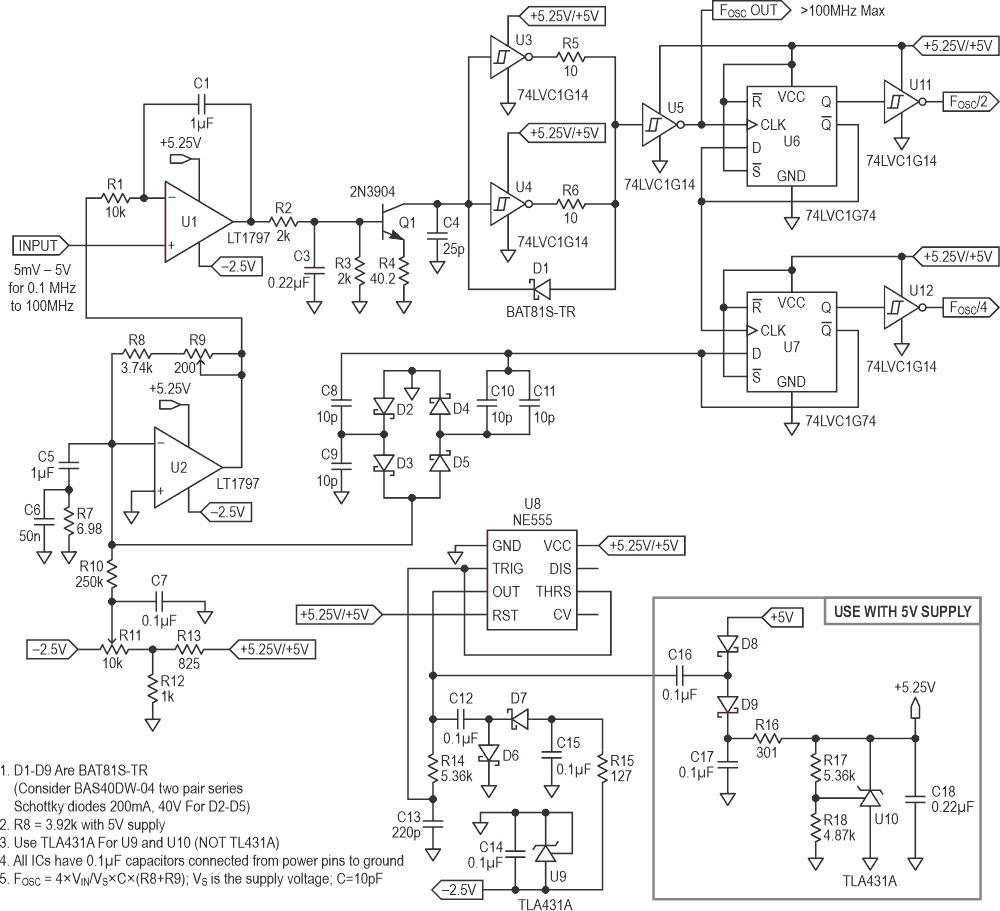Stephen Woodward, a prolific circuit designer with way more than 100 published Design Ideas (DIs), had his “80 MHz VFC with prescaler and preaccumulator” [1] published on October 17, 2024, as a DI on the EDN website.
Upon reading his article, I was eager to simulate it and try to push its operation up to 100 MHz, if possible, while maintaining its basic simplicity and accuracy. However, Stephen Woodward got there before I did [2]! For the record, I had almost finished my design before I saw his latest one on the EDN website.
I won’t discuss the details of the circuit operation because they are so similar to those of the above-referenced DIs. However, there are added features, and the functionality has been tested by simulation.
Features
My voltage-to-frequency converter (VFC) circuit (Figure 1) has a high impedance input stage, it can operate reliably beyond 100 MHz, it can be operated with a single 5.25-V supply (or a single 5-V supply with a few added components), and it has been successfully simulated. Also, adjustments are provided for calibration.
 |
|
| Figure 1. | VFC design that operates from 100 kHz to beyond 100 MHz with a single 5.25-V supply, providing square wave outputs at 1/2 and 1/4 the main oscillator frequency. |
This circuit provides square wave outputs at one-half and one-fourth the main oscillator frequency. These signals will, in many cases, be more useful than the very narrow oscillator signal, which will be in the 2 ns to 5 ns range.
The NE555 (U8) provides a 500 kHz signal, which drives both a negative voltage generator for a -2.5-V reference and a voltage doubler used to generate a 5.25-V regulated supply that is used when a single 5-V supply is desired. TLA431As are used as programmable Zener diodes, NOT TL431As. Unlike the TL431A, the TLA431A is stable for all values of capacitance connected from the cathode to the anode.
Two adjustments are provided: Both a positive and a negative offset adjustment are provided by R11, and R9 adjusts the gain of the current-to-voltage converter, U2. I suggest using R11 to set the 100-kHz signal with 5 mV applied to the input and using R9 to set the 100-MHz signal with a 5-V input. Repeat this procedure as required to maximize the accuracy of the circuit.
Possible limitations
This circuit may not give highly accurate operation below 100 kHz because of diode and transistor leakage currents, but I expect it to operate at the lower frequencies at least as well as Woodward’s circuits. Operation down to 1 Hz or 10 Hz is, in my opinion, mostly for bragging rights, and I am not concerned about that.
I expect this VFC to be useful mostly in the 100 kHz to 100 MHz frequency range: a 1 to 1000 span. Minute diode/transistor leakage currents in the nanoamp range and PCB surface leakage may cause linearity inaccuracies at the lower frequencies.
The capacitor charging current provided by transistor Q1 is in the several microamps range at 100 kHz; below that, it is in the nanoamp range. Having had some experience with environmental testing, I think it would be difficult to build this circuit so that it would provide accurate operation below 100 kHz in an environment of humidity/temperature of 75%/50 °C.
Some details
When simulated with LTspice, the Take Back Half circuit [3] with 1N4148 diodes did not provide acceptable results above about 3.5 MHz when driven by a square wave signal with 2-ns rise/fall times, so I used Schottky barrier diodes instead, which worked well beyond 25 MHz, the maximum frequency seen by the Take Back Half circuit [1,3]. The Schottky diodes have somewhat higher leakage current than the 1N4148s, but the 1N4148 diodes would require the highest frequency signal to be divided down to 3.5 MHz to operate well in this application.
I used two 74LVC1G14s to drive C4, the ramp capacitor, because I was not convinced one of them was rated to continuously drive the peak or rms current required to reset the capacitor when operating at or near 100 MHz. And using a 25-pF capacitor instead of just using parasitic and stray capacitance allows better operation at low frequencies because leakage currents are a smaller percentage of the capacitor charging current. (Obviously, more ramp capacitance requires more charging current.)
The op-amp
If you want to use a different op amp, check the specs to be sure the required supply current is not greater than 3 mA worst case. Also, it must accommodate the necessary 7.75 V with some margin. Critically, the so-called rail-to-rail output must swing to within 100 mV of the positive rail with a 1.3-mA load at the maximum operating temperature.
Be advised
Look at renowned Jim Williams’ second version of his 1 Hz to 100 MHz VFC for more information about the effort required to make his circuit operate well over the full frequency range [4], [5]. See reference 5 and look at the notes in Figure 1 and Table 1.
References
- Woodward, Stephen. "80 MHz VFC with prescaler and preaccumulator."
- Woodward, Stephen. "100-MHz VFC with TBH current pump."
- Woodward, Stephen. "Take-Back-Half precision diode charge pump."
- Designs for High Performance Voltage-to-Frequency Converters
- Williams, Jim. "1-Hz to 100-MHz VFC features 160-dB dynamic range."